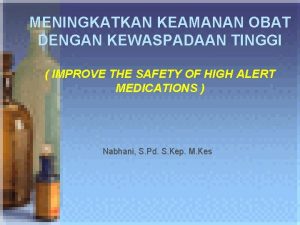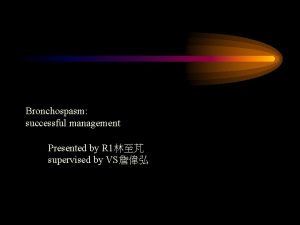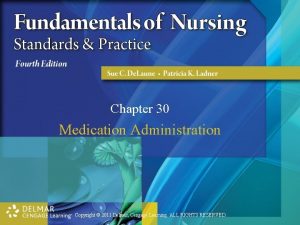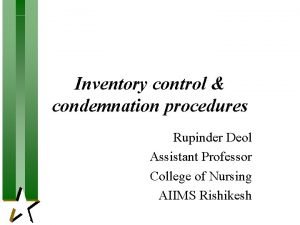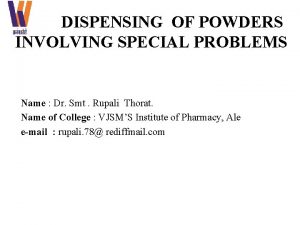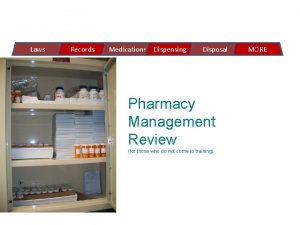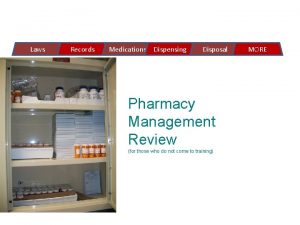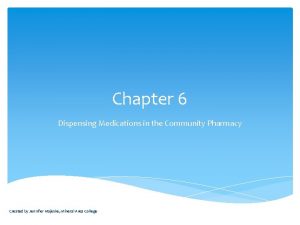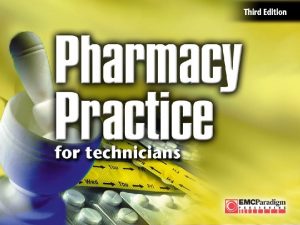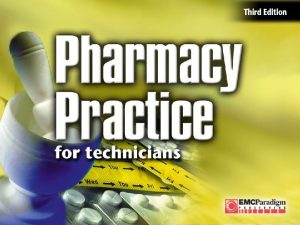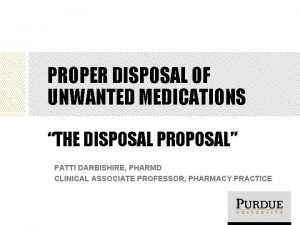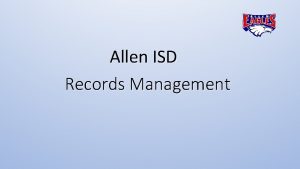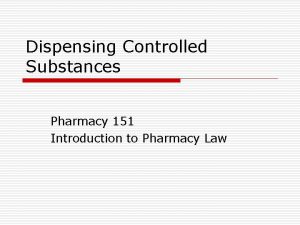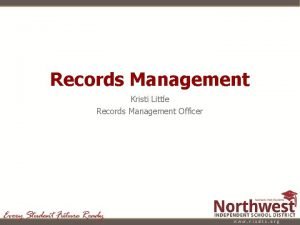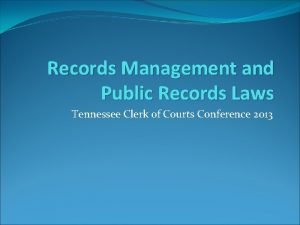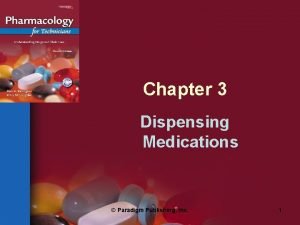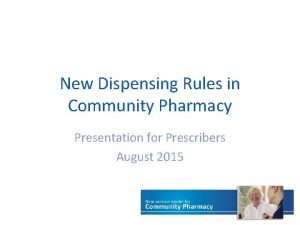Laws Records Medications Dispensing Disposal Pharmacy Management Review





















- Slides: 21

Laws Records Medications Dispensing Disposal Pharmacy Management Review (for those who do not come to training) MORE

Laws Affecting Prescription Dispensing Approval of Medications for Use in the United States The Food and Drug Administration (FDA) is the federal agency that supervises the development, testing, purity, safety, and effectiveness of prescription and OTC medications. The FDA must approve medications before they can be sold in the US. The FDA also regulates the advertising of prescription medications and the labeling of prescription and OTC medications. Controlled Substances Controlled substances are medications with significant potential for abuse. The Comprehensive Drug and Control Act of 1970, referred to as the Controlled Substance Act (CSA) regulates manufacturing, distribution, prescribing and dispensing of controlled substances through the Drug Enforcement Administration (DEA). Prescribers are assigned DEA numbers which authorize them to prescribe controlled substances. Child-Resistant Containers The Consumer Product Safety Commission (CPSC) oversees the Poison Prevention Packaging Act. The CPSC requires most prescriptions for oral use to be dispensed in child-resistant containers unless patients or prescribers request otherwise. NEXT

State Agencies (BOP, DOH) Medical providers, such as Physicians (MD) and osteopaths (DO) are authorized to prescribe prescription medications for use within the practitioners’ area of expertise as granted by the State Board of Pharmacy and/or other state agencies such as the Department of Health (DOH). Some states permit physicians assistants (PA), nurse practitioners (NP) to prescribe certain medications according to specific guidelines. These type of practitioners may be assigned a DEA number like an MD representing authorization for them to prescribe controlled substances. Medication dispensing by practitioners varies by state. For example, some states allow for dispensing but only for medication samples. It is imperative that your healthcare attorney verify what type of medications (controlled schedules, non-controlled substances, medication samples) can be dispensed in your office. You must also verify who is authorized to distribute these. For example, in the State of ____, PA’s are authorized to distribute Schedule III-V medications in the clinic but ONLY with a physician on-site. When both the federal and state government address a particular situation, the stricter law applies.

Inspections Boards employ inspectors/investigators to inspect medication dispensing locations for compliance with state pharmacy or department of health laws and regulations. Inspectors conduct regular inspections. TIPS: 1. Be friendly with your local inspectors. They are very busy professionals. Some see up to 800 sites a quarter. 2. Ask for identification if an inspector comes to your clinic. 3. Notify the clinic owner or MD on site if an inspector is present. State pharmacy boards can revoke, suspend, or place on probation licenses of those who are found guilty, after due process, of violating laws or regulations.

Security Because of the presence of medications in the clinic, the staff must take precautions to keep the prepackaging area and narcotic cabinet secure. Here are some general guidelines about how to maintain security. The staff must: l l l Keep the narcotic cabinet door closed when not in use. Not allow patients or non-MWLC personnel into the prepackaging/narcotic cabinet storage area. Never have both sets of keys in their locks when not in use.

Medications arrive from PDRx in the manufacturer’s packaging, called stock bottles. The FDA requires all prescription medication stock bottle labels to contain certain information. The three pieces you are most concerned with are: § Lot# § NDC# § Expiration Date Manufacturer Bottles

Medications Prepackaged Vials The first child-proof safety cap was suggested by Dr. Jay Arena, a pediatrician at Duke Hospital who persuaded the producer of St. Joseph's Aspirin to place a safety cap on its product. Their aspirins had been colored and flavored to appeal to children, but of course, they thought they were sweets. PDRx occasionally ships a small bag of non-child proof caps with your empty vial orders – NEVER USE THESE for liability reasons.

Guidelines for Repackaging l l l Only one medication should be repackaged at a time. This reduces chances of contaminating one medication with residues of another where a patient may have severe allergies. Repackaged medications should not be released for distribution to patients until checked and approved by a medical provider. Electronic pill counters should be maintained according to manufacturers’ instructions and cleaned after each repackaging session. Do not cross-contaminate by packaging in an area where food or drinks are consumed. Practice GCP’s by wearing gloves, and not eating or drinking during session. Maintain written records for each batch for at least a year. (Some state require a longer time period. ) These records should include: l l l The date of repackaging Name of the medications repackaged NDC number of the medications repackaged Lot numbers Initials of the provider who checks the batch Name of the person repackaging the medication

Guidelines for Repackaging Expiration dates assigned to repackaged medications ensure that products dispensed are effective at the time of use. Repackaging and exposing the medication to the environment may affect the medications shelf-life. Therefore, the expiration date you put on the label is not the same as the manufacturer’s date. The expiration date should follow one of the following rules: 1. 2. The repackaged expiration date cannot be more than six months after the repackaging date; or The repackaged expiration date cannot be more than 25% of the time between the original manufacturer’s expiration date and the date of repackaging. For example: If you are repackaging some Testosterone on 1/31/10 and the expiration date on the manufacturer’s original container is four months later on 4/30/10. The repackaged medication must show an expiration date no later than 2/28/10, which is one month (25% of 4 months) after the manufacturers expiration date.

Hispac Pill Counter tips This cover pops up and the black round knob in the middle pulls up to help with cleaning after each use. Use a large measuring cup in counting out 1000 quantity bottles. Ensure this silver tab is pushed down in position.

Recordkeeping It is important to keep records organized and readily retrievable. They can be key for you having a passing inspection grade. You may organize the records in any manner you see fit as long as they are retained in the appropriate timeline that meets Federal and State specific guidelines. We recommend a 3 -Binder system which consists of: Working Inventory Binder: Contains all prepackaging inventory sheets and pre-printed repackaging labels with tabs separating different lot #’s. Daily Report Log: Contains signed and dated daily prescription reports and/or the daily signature log. Master Records Binder: Holds important information that is not accessed on a daily basis such as Biennial Inventory reports, Master Signature log sheet, DEA-41 Forms, copies of licenses or registrations and receipts from reverse distributors.

Confidentiality It is crucial that you keep personal or health information about patients strictly confidential at all times. Discussing a patient’s health information with anyone other than the patient, the patient’s caregiver or the providers you work with is a serious violation of ethics and could expose the clinic to a law suit. The training in Tampa provides you with the “bare bones” federal overview of the Privacy Rule within HIPAA. Make sure you obtain specific information with regards to policies and procedures from your clinic owner. Each state may have specific privacy requirements – become familiar with these state-required procedures as well.

HIPAA + Pharmacy Management Although your responsibilities may incorporate more procedures than what is outlined here, the following is a checklist of some of the procedures you should know to comply with the Privacy Rule. How should you handle patient requests for access to their PHI such as Rx History? 2) How do you handle transferring prescription records to another clinic? 1) a. What forms are required for this process? 3) How should you dispose of PHI such as a duplicate Rx label? 4) Where do I place the prescription vial in the check out area so PHI cannot be seen by other customers? (in this case vial was not directly handed to patient) 5) How should you handle a patient who begins talking about their medical history while standing in a hallway or checkout area?

What is PHI? Protected Health Information (PHI) is any information that is collected in the clinic that can be used to identify a patient. Billing invoices, prescriptions records and patient charts are some examples. When it comes to pharmacy management, PHI includes : üThe patient’s name üThe patient’s address üPrescription number üTelephone number üDate of birth üName of employer as Wellness partner

Medication Returns Return of dispensed medication to the prescriber is not allowed in most states. Check your state specific requirements. At no time should medications be taken back otherwise, unless it was a dispensing error. Patients can be directed to www. whitehousedrugpolicy. gov to read the publication Federal Guidelines on Personal Rx Drug Disposal. Flushing of medications has been prohibited in most states due to contamination of water tables. The FDA has released permissions allowing high abuse medications such as Oxycodone to be immediately flushed, if necessary.

Theft or Losses TITLE 21 CODE OF FEDERAL REGULATIONS, PART 1301. 74 (c) The registrant shall notify within the DEA within one business day of discovery of theft of loss. l All in-transit losses of controlled must be reported. l The registrant shall complete and submit a DEA Form 106. l

What Is a Significant (Meaningful) Loss? The actual quantity of controlled substance lost in relation to the type of business. l The specific controlled substances lost. l Whether the loss of the controlled substances can be associated with access to those controlled substances by specific individuals, or whether the loss can be attributed to unique activities that may take place involving the controlled substance. l l A pattern of losses over a specific time period whether the losses appear to be random, and the results of efforts taken to resolve the losses; and if known; whether the specific controlled substances are likely candidates for diversion; local trends and other indicators of the diversion potential of the missing controlled substances.

DEA Form 106 – now an online process REPORT OF THEFT OR LOSS OF CONTROLLED SUBSTANCES l l l Date of Theft or Loss Notifying Police Number of Thefts Type of Theft or Loss Purchase Value of the Controlled Substances Pharmaceuticals or Merchandise Taken

Back or second page of DEA 106 • Trade Name of Substance or Preparation • Name of Controlled Substance in Preparation • Dosage Strength and Form • Quantity

Lower Portion of second page • Signature • Title • Date of Form

DEA Diversion Contact Information For Additional Information www. DEAdiversion. usdoj. gov or www. dea. gov
 Disadvantage of the individual prescription order system
Disadvantage of the individual prescription order system Common pediatric medications
Common pediatric medications Tuohy needle sizes
Tuohy needle sizes Hepatitis d
Hepatitis d List of high-alert medications jci
List of high-alert medications jci Chapter 11 medications and drugs
Chapter 11 medications and drugs Mock code medications
Mock code medications The nurse has obtained the patient's oral medications
The nurse has obtained the patient's oral medications Chapter 30 administering medications
Chapter 30 administering medications Medications
Medications Sick day medication
Sick day medication Medical reconciliation definition
Medical reconciliation definition High risk medications
High risk medications Chapter 30 administering medications
Chapter 30 administering medications Peripheral nervous system medications
Peripheral nervous system medications Chapter 17 credit records and laws
Chapter 17 credit records and laws Useless laws weaken the necessary laws
Useless laws weaken the necessary laws Condemnation and disposal in material management
Condemnation and disposal in material management Condemnation and disposal in material management
Condemnation and disposal in material management Dispensing techniques
Dispensing techniques Deliquescent powders are...
Deliquescent powders are... Udd
Udd




